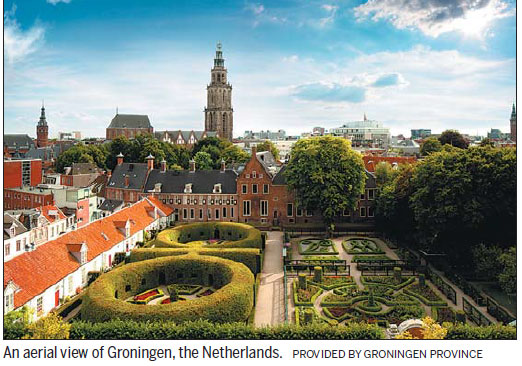City has historical connection to Netherlands
Dutch engineer who helped design city is buried at foot of Jianshan Mountain
When speaking of the Netherlands, most residents of Nantong, Jiangsu province, recall Dutch engineer Hendrik Christiaan de Rijke and the contributions he made to the city.
Born in 1890, de Rijke grew up in Groningen, now the largest city in the north of the Netherlands.

De Rijke started work immediately upon his arrival and, after careful research and field studies, he came up with a detailed report on how to use water projects to curb flooding in Nantong.
His report was adopted and he personally supervised the construction of some of the resulting projects in Nantong during his three years in China.
However, de Rijke's hard work regimen affected his health negatively and in August 1919, during an inspection of a construction site, he was infected with cholera.
He died on his way back to Nantong.
Zhang held a public funeral to honor de Rijke and buried him at the foot of Jianshan Mountain.
Since then, the families of Zhang and de Rijke have maintained contact throughout the past century.
Their close ties also fostered good relations between Nantong and the Netherlands and de Rijke's family members have visited Nantong from time to time to pay tribute to him.
They also helped to boost economic and cultural exchanges between Nantong and the European country. In 2014, Helenus de Rijke was appointed senior advisor for international cooperation affairs of the Nantong City People's Association for Friendship with Foreign Countries, to help promote bilateral communications and cooperation.
The city also has a Dutch Street in the pipeline, with plans to construct buildings on the street in the Dutch architectual style.
It is designed to be a commercial street selling food and clothes and home to entertainment venues.
Located at the estuary of the Yangtze River and neighboring the Yellow Sea, which endow the city with the descriptions of "golden waterways" and "gold coast", Nantong is considered a "gateway to sea and river" and enjoys an advantageous location.
Nantong was among the first batch of 14 port cities in China that opened up to the world. With a population of more than 7.6 million and an area of 8,000 square kilometers, the city was one of the country's first cities to embrace modernity.
Home to four State-level development zones and a national high-tech zone, Nantong ranked 25th among all Chinese cities by GDP in 2014.
The city also has a large number of scenic spots on its long coastline.
Among them, Langshan Mountain, Lyusi Port and Liya Mountain are all places of interest.
Surrounded by other mountains, Langshan Mountain, or Wolf Mountain, in the south of Nantong is a favorite destination for Buddhists, as it is home to many ancient temples, most of which were built between the Song (960-1279) and Qing (1644-1911) dynasties. Records show that monk Jian Zhen from the Tang Dynasty (AD 618-907), who visited Japan several times to promote Buddhism, once protected himself from strong winds at a house on the mountain on one of his trips.
The mountain is also special to Catholics, as it has a Catholic church built during the late Qing Dynasty that the Roman Curia designated one of 12 shrines in China in the 1930s.
In contrast to Langshan Mountain, which is known for its cultural heritage, Liya Mountain in the Yellow Sea is a natural wonder, built up from oyster shells and sediments transported by the Yangtze River more than 1,690 years ago.
The narrow island resembles a mountain when the tide is out, but is only a reef when the tide is in. The Oceanic Administration named it a special ocean protection zone in 2006 for its high value in scientific research.
dingcongrong@chinadaily.com.cn


















